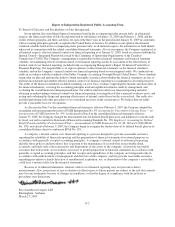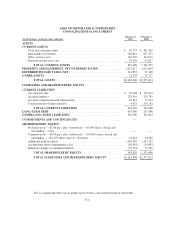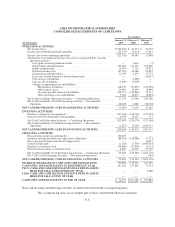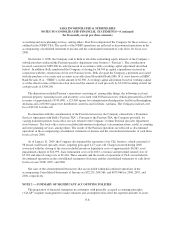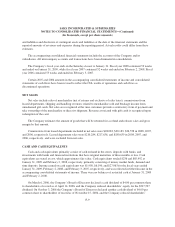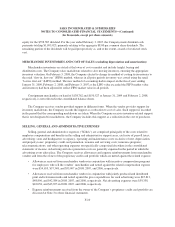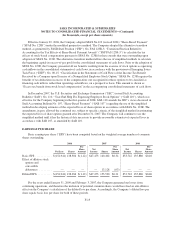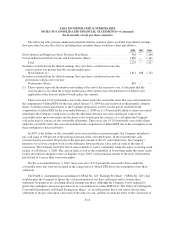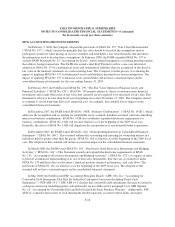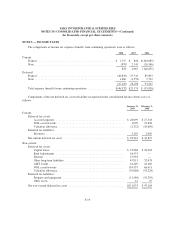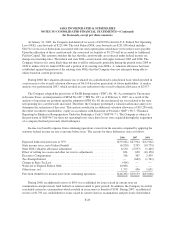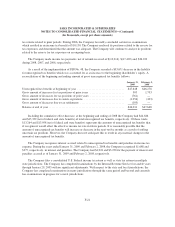Saks Fifth Avenue 2008 Annual Report Download - page 66
Download and view the complete annual report
Please find page 66 of the 2008 Saks Fifth Avenue annual report below. You can navigate through the pages in the report by either clicking on the pages listed below, or by using the keyword search tool below to find specific information within the annual report.SAKS INCORPORATED & SUBSIDIARIES
NOTES TO CONSOLIDATED FINANCIAL STATEMENTS—(Continued)
(In thousands, except per share amounts)
percentage of sales in excess of specified levels. Most of the Company’s lease agreements include renewal
periods at the Company’s option. The Company recognizes rent holiday periods and scheduled rent increases on
a straight-line basis over the lease term beginning with the date the Company takes possession of the leased space
and includes such rent expense in Store Pre-Opening Costs. The Company records tenant improvement
allowances and rent holidays as deferred rent liabilities on the consolidated balance sheets and amortizes the
deferred rent on a straight–line basis over the life of the lease to rent expense in the consolidated statements of
income. The Company records rent liabilities on the consolidated balance sheets for contingent percentage of
sales lease provisions when the Company determines that it is probable that the specified levels will be reached
during the fiscal year.
SELF-INSURANCE RESERVES
The Company self-insures a substantial portion of its exposure for costs related primarily to employee
medical, workers’ compensation and general liability. Expenses are recorded based on estimates for reported and
incurred but not reported claims considering a number of factors, including historical claims experience, severity
factors, litigation costs, inflation and other assumptions. Although the Company does not expect the amount it
will ultimately pay to differ significantly from its estimates, self-insurance reserves could be affected if future
claims experience differs significantly from the historical trends and assumptions.
DERIVATIVES
The Company uses financial derivatives to manage its costs and risks in conjunction with specific business
transactions. All derivative instruments are recognized on the balance sheet at fair value. The Company cancelled
all of its interest rate swap agreements during 2004 resulting in $3,100 of net losses. The Company had total
unamortized net gains (losses) of $53, $0, and ($350) at January 31, 2009, February 2, 2008, and February 3,
2007, respectively, that are being amortized as a component of interest expense through 2010.
The Company issued $230,000 of convertible senior unsecured notes during 2004 that bear interest of 2.0%
and mature in 2024. The Company used approximately $25,000 of the proceeds from the issuance of the notes to
enter into a convertible note hedge and written call options on its common stock to reduce the Company’s
exposure to dilution from the conversion of the notes.
STOCK-BASED COMPENSATION PLANS
The Company maintains an equity incentive plan for the granting of options, stock appreciation rights,
performance shares, restricted stock, and other forms of equity awards to employees and directors. Options
granted generally vest over a four-year period after grant and have an exercise term of seven to ten years from the
grant date. Restricted stock and performance shares generally vest in three years after the grant date, although the
plan permits accelerated vesting in certain circumstances at the discretion of the Human Resources and
Compensation Committee of the Board of Directors.
Compensation cost for restricted stock and performance shares that cliff vest is expensed on a straight line
basis over the requisite service period. Restricted stock and performance shares with graded vesting features are
treated as multiple awards based upon the vesting date. The Company records compensation costs for these
awards on a straight line basis over the requisite service period for each separately vesting portion of the award.
Compensation cost for stock option awards with graded vesting are expensed on a straight line basis over the
requisite service period.
F-12


